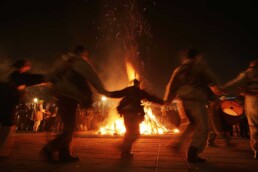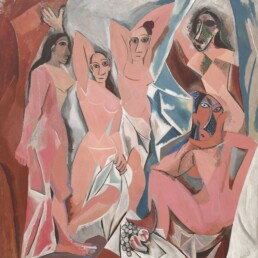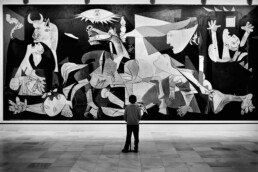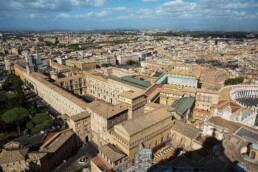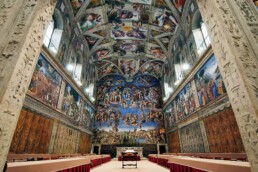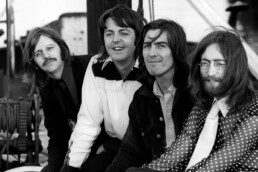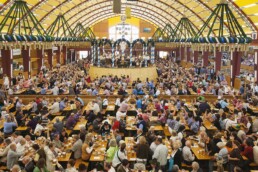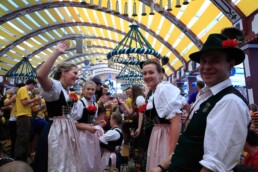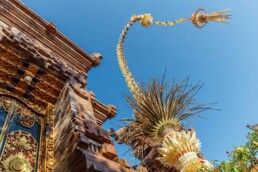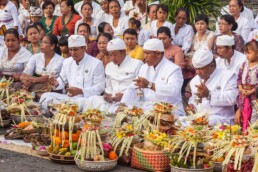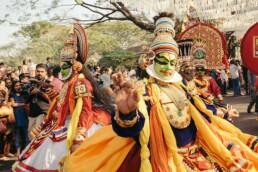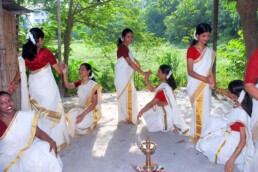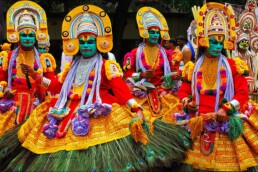Halloween: Dancing with Shadows in the Spirit of Samhain
The brisk fall air lends a hint of mystery as leaves dance to the ground in amber and scarlet. It’s that time of year when carved pumpkins flash frightening grins, costumed creatures prowl the streets and the line between the living and the dead feels vanishingly thin. Halloween, a night steeped in lore and tradition, promises thrills and a hint of the supernatural. But beyond the candies and costumes is a rich of history that has evolved over millennia.
Halloween’s origins may be traced back over 2.000 years to the ancient Celts, who lived in what is now Ireland, the United Kingdom, and northern France. For these agrarian communities, the year was divided into two parts, with November 1st signalling the start of the new year and the arrival of winter. This shift was marked by the festival of Samhain (pronounced “sow-in”), which means “summer’s end.”
Samhain was regarded as a liminal period in which the veil between the living and the dead weakened. It was thought that ghosts may return to Earth, causing both comfort and chaos. Ancestors were revered, but malignant forces were also feared. To protect themselves, the Celts lit enormous bonfires on hilltops to ward off evil spirits. People disguised themselves and confused roaming ghosts by wearing costumes and masks, which were often constructed of animal skins and heads.
As the Roman Empire expanded into Celtic regions, new customs became entwined with Samhain traditions. The Romans celebrated “Feralia”, a late-October celebration celebrating the passing of the dead, as well as “Pomona”, the goddess of fruit and plants. The latter may have helped to establish the ritual of bobbing for apples, which is still played at Halloween festivities.
As Christianity grew, the Church attempted to replace pagan holidays with Christian ones. By the ninth century, All Saints’ Day (also known as All Hallows’ Day) was created on 1st November to commemorate all saints and martyrs. The evening before became known as All Hallows’ Eve, which eventually evolved into Halloween. Later, All Souls’ Day on 2nd November continued the tradition of remembering the dead by combining Christian and pagan traditions.
Irish and Scottish immigrants brought Halloween rituals to North America in the nineteenth century. The Irish Potato Famine caused a huge inflow in the mid-1800s, bringing with it habits like “guising”, in which children dressed up and performed duties in return for food or money.
In America, these customs merged with Native American autumn festivities and other European traditions. As a result, Halloween took on a distinct American flavour. By the late nineteenth century, there was a push to make Halloween a community-centered celebration, with emphasis on games, seasonal sweets, and joyful gatherings. Superstitious and haunting features were minimised in favour of communal celebration.
In the early twentieth century, Halloween evolved into a secular but community-oriented event. However, it wasn’t until the 1920s and 1930s when trick-or-treating became widely popular. Trick-or-treating, based on ancient rituals of leaving offerings for ghosts and the mediaeval tradition of “souling”, in which the destitute would go door-to-door offering prayers for the dead in exchange for food, provided a mechanism to manage the wild customs of Halloween night.
The economic boom that followed World War II entrenched trick-or-treating as a staple of Halloween. Candy companies seized upon the opportunity, and mass-produced costumes were widely accessible. The holiday was changed into a children’s festival, with a focus on fun over dread.
Movies, television, and literature have all had a big impact on Halloween’s current image. Classic horror films contributed monsters such as Dracula, Frankenstein’s monster, and werewolves to the holiday’s imagery. Contemporary franchises delve into themes such as hauntings, demonic possession, and psychological trauma, adding layers to our cultural understanding of fear and the unknown.
Haunted houses, corn mazes and hayrides are popular attractions that provide thrill seekers with immersive experiences. These venues frequently use expensive special effects and storytelling to immerse visitors in unsettling landscapes. Halloween Horror Nights at theme parks draw international crowds, demonstrating the holiday’s commercial success.
Costumes remain an important aspect of Halloween, ranging from simple disguises to complex demonstrations of creativity. The popularity of cosplay (costume play) has blurred the distinction between Halloween and other types of character embodiment. People now spend weeks or months creating detailed costumes to honour not only the frightening but also personalities from pop culture, history, and beyond.
Halloween generates billions of dollars in income each year, and commercialisation is at an all-time high. Retailers sell a wide variety of items, from decorations and costumes to themed food and beverages. Some criticise the commercialisation, claiming that it takes away from the holiday’s historical and cultural significance.
Environmental concerns have also been raised, particularly about the use of single-use plastics in decorations and costumes. There is an increasing trend towards sustainable festivities that promote homemade costumes, reused decor, and environmentally friendly methods.
Despite commercialisation and changes throughout time, Halloween remains captivating. Its enduring value stems from humanity’s intrigue with the unknown, as well as the ability to explore identity, community, and tradition. Whether it’s the thrill of a ghost story, the joy of a child’s first trick-or-treat, or the solemn memory of those who have died, Halloween provides an opportunity to move outside the norm.
In an increasingly interconnected world, Halloween serves as a cultural touchstone, emphasising both our common human experiences and the great diversity of our cultures. It tells us that, even as time passes, the echoes of ancient practices persist, encouraging us to dance with shadows and enjoy the secrets that have captivated humanity for centuries.
Embracing Color and Chaos in the Mind of Picasso
Pablo Ruiz Picasso, born on 25th October 1881, in the Andalusian city of Málaga, Spain, was destined to become an artist. His father, Don José Ruiz y Blasco, was a painter and art teacher who recognised and encouraged his son’s outstanding potential from an early age. When Pablo was a teenager, the Picasso family relocated to Barcelona, a city rich in avant-garde ideas and artistic fervour. Picasso frequented Els Quatre Gats, a café that hosted modernist poets, artists, and philosophers.
Picasso’s early works were rooted in realism, but the death of his close friend Carlos Casagemas in 1901 spurred a significant shift. Picasso’s palette darkened when he entered his “Blue Period” (1901-1904), which was characterised by blue and green tones. His subjects were frequently marginalised figures—beggars, prostitutes, and the poor—who reflected themes of melancholy and human misery. Paintings such as “The Old Guitarist” exemplify this era’s emotional depth.
Around 1904, his attitude and palette improved, ushering in the “Rose Period” (1904-1906). This phase was characterised by warm pink and orange tones, with circus performers, harlequins, and clowns. Works like “Family of Saltimbanques” indicate a modest change towards a lighter, more romantic sensibility while hinting at future creative progression.
Picasso’s interaction with African and Iberian art about 1907 constituted a watershed moment. Fascinated by the stylised forms and symbolic significance of tribal masks and sculptures, he began to incorporate them into his artwork. This phase, also known as “African-influenced” or “Proto-Cubism”, resulted in one of his most breakthrough works, “Les Demoiselles d’Avignon” (1907). This bold image of five female nudes, complete with deformed features and fractured planes, disrupted traditional perceptions and laid the groundwork for a new creative vocabulary.
Picasso and French artist Georges Braque pioneered Cubism, a revolutionary movement in which items were disassembled into geometric patterns and reassembled on canvas from numerous perspectives. This method challenged standard concepts of space and representation. The Analytical Cubism period (1908-1912) included subdued tones and complicated, interconnected planes, as shown in works such as “Girl with a Mandolin”.
Around 1912, Synthetic Cubism evolved, introducing brighter colours and the use of mixed media, such as newspaper clippings and patterned paper, thereby inventing the collage technique. Picasso’s “Still Life with Chair Caning” exhibits this novel combination of materials and ideas, blurring the distinction between high art and everyday goods.
Perhaps no single piece better captures Picasso’s idealism and political participation than “Guernica” (1937). Picasso’s mural-sized painting, commissioned by the Spanish Republican government for the Paris International Exposition, was an emotional reaction to the destruction of the Basque village of Guernica during the Spanish Civil War. On 26th April 1937, German and Italian warplanes backing Spanish Nationalist troops launched a devastating aerial bombardment on the town, killing a large number of civilians.
“Guernica” depicts the horrors of war in harsh monochrome. The chaotic composition depicts agonised figures—a gored horse, a crying lady cradling her dead kid, and a mutilated soldier—all illuminated by a single, glaring light bulb. The bull, frequently seen as a sign of brutality and darkness, dominates the scene. The broken, overlapping forms evoke a sensation of displacement and horror. Picasso’s strong vision transcended the specifics of the incident, creating a universal condemnation of war’s evils.
The artwork toured the world, bringing awareness of the humanitarian situation resulting from the Spanish Civil War and cementing Picasso’s reputation as a passionately active political artist. “Guernica” remains a powerful anti-war message and a classic of twentieth-century art.
His idealism went beyond his canvases. A lifelong pacifist, he joined the French Communist Party in 1944, seeing it as a way to promote peace and social justice. His political ideals frequently inspired his art, as evidenced by works such as “Dove of Peace”, which became the logo for the World Peace Congress in 1949. Despite criticism and political difficulties throughout the Cold War, Picasso stayed firm in his beliefs, using his celebrity to advance humanitarian causes.
Picasso’s style evolved throughout his busy career, as he experimented with sculpture, ceramics, printmaking, and stage design. His relentless curiosity and contempt for conventional rules catapulted art to new heights. Picasso had created almost 20,000 pieces by the time he died on 8th April 1973, each one showing his unwavering pursuit of creativity. His contribution to modern art is immense. He broke the illusion of perspective and representation, paving the way for abstract expressionism and inspiring many artists across disciplines. His ability to both honour and deconstruct artistic traditions demonstrates the duality at the heart of his talent.
Pablo Picasso’s life was an ongoing exploration of form, emotion, and ideation. His art not only reflects the intricacies of the human condition, but it also serves as a historical record of the stormy 20th century. Picasso’s greatest paintings, including “Guernica”, tackled the harsh realities of his day and championed the eternal power of artistic expression as a force for reflection and change. His legacy leaves an everlasting mark on the canvas of modern society, pushing future generations to push the limits of creativity and thought.
The Sistine Chapel: A Journey Through Art and Faith
The Sistine Chapel, located within the Apostolic Palace in Vatican City, is a lasting tribute to Renaissance art and the Catholic Church’s profound spiritual traditions. The chapel, revered not only for its beautiful frescoes but also for its vital role in the papal conclave, serves as a bridge between artistic talent and ecclesiastical heritage.
Between 1473 and 1481, Pope Sixtus IV della Rovere commissioned the construction of the Sistine Chapel, which bears his name. The chapel was designed to serve as both the Pope’s private chapel and a venue for significant papal rituals such as ecclesiastical tribunals and, most notably, the papal conclave. Built on the foundations of the Cappella Magna, a mediaeval chapel, the new structure was designed to symbolise the Papacy’s majesty and authority during a period of significant ecclesiastical and political dominance.
Baccio Pontelli planned the Sistine Chapel, and Giovannino de’ Dolci oversaw its construction. The chapel’s dimensions—approximately 40,9 metres in length, 13,4 metres in width, and 20,7 metres in height—reflect the proportions of Solomon’s Temple as recounted in the Old Testament, symbolising the Papacy’s connection to the hallowed traditions of ancient Israel.
Prior to Michelangelo’s transformative work, the chapel’s walls were decorated by a group of Renaissance masters between 1481 and 1482. Pope Sixtus IV commissioned artists including Sandro Botticelli, Pietro Perugino, Domenico Ghirlandaio, Cosimo Rosselli, Luca Signorelli, and others to create a cohesive visual story. The frescoes on the north and south walls represent parallel incidents from the lives of Moses and Jesus Christ, making a theological link between the Old and New Testaments.
These visual stories were more than just decorative; they served a didactic purpose by displaying essential doctrinal ideas and maintaining the continuity of Christian salvation history. The placement of papal images and modern persons inside these biblical scenarios served to enhance the Church’s and its leaders’ authority.
Michelangelo Buonarroti was commissioned in 1508 by Pope Julius II to repaint the chapel’s ceiling, which had previously shown a simple blue sky with stars. Although Michelangelo considered himself primarily a sculptor and was first hesitant to take on the project, he eventually accepted the challenge, which would solidify his position as one of history’s greatest artists. He worked on a specially designed scaffold for four years, from 1508 to 1512, painting around 500 square meters of frescos. The ceiling’s central panels vividly depict nine incidents from the Book of Genesis, beginning with “The Separation of Light from Darkness” and ending with “The Drunkenness of Noah.” Among these, “The Creation of Adam” is a classic picture of divine creation, depicting the moment God gives life to the first man with the touch of his fingertip.
Surrounding these primary storylines are pictures of prophets and sibyls—ancient seers from both Jewish and pagan traditions—who predicted the arrival of the Messiah. Michelangelo’s inclusion of these characters exemplifies a combination of classical and Christian motifs, which reflects Renaissance humanist aspirations.
Michelangelo returned to the Sistine Chapel in 1535 to paint “The Last Judgement” on the altar wall, as commissioned by Pope Paul III. Completed in 1541, this massive painting represents Christ’s Second Coming and the final judgement of souls. The composition is both dramatic and detailed, with over 300 figures arranged in a complex pattern to depict the event’s turbulent nature. The overwhelming imagery of redemption and damnation reflects contemporary religious concerns, notably in the aftermath of the Protestant Reformation.
“The Last Judgement” sparked debate upon its release owing to the prominent exhibition of naked individuals, which some contemporaries thought unsuitable for a hallowed venue. In reaction to the Council of Trent’s rules on holy art, steps were taken to conceal the nudity, with artist Daniele da Volterra adding drapery to numerous figures, earning him the nickname “Il Braghettone” (“The Breeches Maker”).
Centuries of candle smoke, humidity, and earlier restoration attempts have covered and faded the frescoes. Between 1980 and 1994, a significant restoration effort was carried out, using modern conservation techniques to remove decades of dust and show the original vibrancy of Michelangelo’s palette. The restoration revived discussions over creative intent and preservation ethics, but it finally allowed the world to see the frescoes in their true glory.
Beyond its standing as a Renaissance art masterpiece, the Sistine Chapel is still significant in terms of religion and culture today. It maintains an active consecrated place within the Vatican and is vital to the Catholic Church’s spiritual life.
Perhaps the most important purpose of the Sistine Chapel today is its role in the papal conclave, which is the process of electing a new Pope. Following the death or resignation of a Pope, the College of Cardinals meets in the chapel to pray and vote, away from other pressures, to assure divine guidance in their decision-making.
The conclave is steeped in history, with rituals such as shutting the chapel to prohibit connection with the outside world and emitting famed smoke signals from a chimney to announce the status of the election. Black smoke indicates an inconclusive vote, whereas white smoke signals the successful election of a new Pope. The setting of the Sistine Chapel, embellished with scenes of judgement and redemption, provides a sombre backdrop to the solemn proceedings, reminding the electors of their immense responsibility.
In addition to its liturgical purposes, the Sistine Chapel has become a global cultural icon, drawing millions of tourists each year. Art historians, theologians, and scholars continue to investigate the frescoes’ artistic techniques, symbolic value, and historical context. The chapel’s influence extends to many aspects of culture, influencing works of literature, music, and visual arts.
The Vatican Museums have implemented steps to maintain the chapel in the face of high visitor numbers, such as climate control equipment and limited entrance regulations. These efforts strive to strike a balance between public access and the preservation of delicate artworks for future generations.
In recent years, technological innovations have made the riches of the Sistine Chapel more available to people all over the world. High-resolution imaging projects and virtual tours enable anyone who are unable to come to Vatican City to enjoy the chapel’s grandeur remotely. These internet projects also function as instructional tools, providing in-depth insights into the work and its relevance.
It is a magnificent junction of art, history, and faith. Its walls and ceilings represent the pinnacle of Renaissance creative achievement, with the footprints of masters who attempted to capture the divine through their skill. Michelangelo’s contributions, in particular, transformed art via dynamic composition, anatomical perfection, and profound emotional depth.
The chapel, which hosted the papal conclave, continues to play an important role in establishing the Catholic Church’s leadership and direction. Its continuing presence despite the temporal changes of the modern world demonstrates the continuity of tradition and spirituality.
The Sistine Chapel is more than just an architectural or artistic marvel; it is a living emblem of humanity’s effort to comprehend the sacred and express it through art. Its legacy spans generations, inspiring meditation on our common past and the transcendent capacity of art to transmit the most profound aspects of the human experience.
Imagine a Better World with John Lennon
John Lennon, born on 9th October 1940, in Liverpool, England, is still one of the most recognisable figures in modern music and culture. As a dreamer, rebel, and artist, Lennon’s vision extended beyond pop stardom to represent a generation’s search for peace, love, and self-expression. His beliefs, music, and activism solidified his reputation as an unrivalled cultural figure. From his early days with The Beatles to his later years as a solo artist, John Lennon’s tale is one of transformation, idealism, and enormous social impact.
John Winston Lennon was born during World War II, a turbulent period that shaped his early experiences with loss and uncertainty. After his parents parted, Lennon was mostly raised by his Aunt Mimi, and his childhood was plagued by emotional anguish. His bond with his mother, Julia, was crucial—she exposed him to music, which fuelled his early love of rock & roll. Julia’s sad death at the age of 17 left an indelible mark on Lennon’s thoughtful and frequently melancholy outlook.
Music became his shelter, and in his early adolescence, he formed The Quarrymen, the skiffle group that would later become The Beatles. Lennon’s rebellious spirit and biting wit were evident from the outset. He was never one to comply with conventional conventions or expectations, which would eventually characterise his public persona. His strong sense of social justice and caustic critique of authority would be evident in both his music and activism, giving him a spokesperson for the countercultural movement of the 1960s and 1970s.
By the early 1960s, Lennon, Paul McCartney, George Harrison, and Ringo Starr had founded The Beatles, a band that would transform not only music but culture as a whole. Their unique sound, which combined rock, pop, and experimental elements, grabbed the world by storm. The Beatles were more than just a musical success; they were cultural architects, reflecting the changing tides of the 1960s. Lennon’s songwriting cooperation with McCartney is still one of the most famous in music history. While McCartney favoured melody and optimism, Lennon added an element of contemplation, wit, and critique. Together, they wrote some of the finest songs of the twentieth century. Tracks like “A Hard Day’s Night,” “Help!,” and “Strawberry Fields Forever” exemplified Lennon’s distinct voice, which alternated between existential longing and humorous criticism.
As the Beatles progressed, so did Lennon’s pursuit of deeper personal, philosophical, and political subjects. The band’s later recordings, particularly “Revolver” and “The White Album”, revealed Lennon’s growing concern with themes of identity, purpose, and peace. During this time, tensions arose among the band as their distinct artistic views diverged. The connection between Lennon and the other Beatles was difficult. While his relationship with McCartney was critical to the band’s success, their divergent artistic trajectories resulted in creative disagreements, particularly near the conclusion of The Beatles’ career. Lennon and Harrison and Starr maintained a close bond, but the stresses of fame and the band’s demanding schedule took their toll. Finally, the disintegration of The Beatles in 1970 constituted a watershed moment for Lennon, propelling him into a new chapter of his life.
John Lennon’s post-Beatles years were defined by his vocal advocacy and determination to change the world beyond music. With his wife, Yoko Ono, by his side, Lennon became an outspoken champion for peace, frequently utilising his notoriety to call attention to political and social causes. Lennon and Ono co-organized renowned peace actions, including the “Bed-Ins for Peace” in 1969, when they invited the world’s media to their hotel room to encourage nonviolence during the height of the Vietnam War.
Lennon’s advocacy was not just symbolic. He aggressively criticised the United States government’s foreign policy and condemned war, racism, and capitalism. His political stance made him a divisive figure, particularly in the United States, where the Nixon administration considered him as a threat owing to his impact among young people. In fact, Lennon faced numerous legal obstacles, including attempts to expel him from the United States, owing to his anti-establishment beliefs. Lennon’s advocacy was centred on his belief in the power of love and human connection to effect positive change. He envisioned a world free of violence, oppression, and greed, a utopia in which people could coexist peacefully. Despite being criticised for being naive, his idealism had a strong impact on millions worldwide.
Perhaps no song better captures Lennon’s vision for the world than “Imagine,” the title track from his 1971 solo album. The song, widely acknowledged as one of the best and most influential in music history, urges listeners to imagine a society without borders, violence, or greed—a world united by peace and common humanity. The song’s simple melodic and lyrical structure betrays its deep impact. “Imagine” marked a significant departure from the elaborate arrangements of his Beatles work. Its minimalist production, anchored by Lennon’s haunting piano chords, allows the message to take centre stage. The words, while idealistic, are delivered with a gentle optimism that invites listeners to explore the prospect of a better future. Lennon’s plea—”You may say I’m a dreamer, but I’m not the only one”—hits home with anyone who believes in the power of hope and change. The song drew both praise and criticism. For some, it was a stirring anthem for peace; for others, it was excessively optimistic. Regardless of interpretation, “Imagine” is an enduring expression of Lennon’s unwavering faith in humanity’s capacity for kindness.
Lennon’s later years were marked by personal reflection as much as artistic resurrection. After taking a temporary break from music in the mid-1970s to focus on raising his son, Sean, Lennon returned to the studio in 1980 with the album “Double Fantasy”, a collaboration with Ono. The album depicted a more calm and contented Lennon, who had found personal peace after years of turmoil. However, the era of rejuvenation was cruelly cut short. On December 8, 1980, a troubled fan, Mark David Chapman, shot and killed Lennon outside his apartment building in New York City. The world was stunned by the untimely and senseless death of an idol who had inspired millions. Vigils were organised around the world, and Lennon’s death signalled the end of an era. He was only 40 years old.
John Lennon’s impact on music, culture, and activism has endured. His courageous investigation of life’s deepest questions—about love, peace, and the human condition—has inspired generations of singers, activists, and dreamers. Whether through his breakthrough work with The Beatles, his activism, or timeless songs like “Imagine,” Lennon’s message is still relevant today.
He wasn’t perfect, and his life was full with inconsistencies. But, in many ways, Lennon’s flaws made him so human, sympathetic, and durable. He challenged the world to envision a better future, leaving an everlasting mark on history.
John Lennon’s legacy includes not only the music he made, but also the values he promoted—ideals that continue to influence how we think about art, politics, and the potential of a more just and peaceful world. As he once observed, “A dream you have alone is just a dream. “A dream you have together becomes a reality.” For millions, Lennon’s dream continues.
Raise a Stein: Oktoberfest is Here!
Every October, the world raises a glass in honour of a centuries-old tradition that began in the heart of Bavaria: Oktoberfest. While the name conjures up pictures of foaming steins and busy beer halls, the history of Oktoberfest is far more interesting than a mere beer celebration. This legendary event, celebrated yearly in Munich and duplicated around the world, is based on a royal wedding, a time-honoured cultural tradition, and a global need for community and mirth.
The first Oktoberfest in German, took place on 12 October 1810. The occasion was the marriage of Crown Prince Ludwig of Bavaria (later King Ludwig I) and Princess Therese of Saxe-Hildburghausen. To commemorate this blissful coupling, the royal family asked Munich residents to join in the celebrations on the fields outside the city gates. These grounds, which became known as Theresienwiese (“Theresa’s Meadow”) in honour of the bride, continue to constitute the focal point of the event today. The first Oktoberfest featured a horse race, which pleased the citizens and established the tone for future events. The event was such a success that it became an annual tradition, eventually growing into the world-famous festival we know today.
While beer has become synonymous with Oktoberfest, it was not always the main attraction. In its early years, the festival was largely an agricultural display intended to promote Bavarian agriculture. For decades, Oktoberfest was a celebration of area produce, cattle, and rural crafts. Farmers and breeders from all across Bavaria would bring their best animals and produce, transforming the event into a large-scale agricultural show honouring the region’s rural heritage. It wasn’t until the late nineteenth century that beer took centre stage. Breweries began erecting big beer tents to serve thirsty festivalgoers, and by the 1890s, these tents had expanded into massive constructions capable of accommodating thousands of people. With beer at the centre of the celebration, Oktoberfest evolved into the iconic event that now attracts millions of people from all over the world.
The beer is crucial to Oktoberfest, and it’s not just any beer. The festival highlights the Märzen variety, a typical Bavarian beer produced especially for the occasion. Märzen, with its amber colour, full-bodied flavour, and higher alcohol concentration, was traditionally produced in March and held in cold cellars all summer. By October, the beer was wonderfully matured and ready to drink. Only six breweries are licensed to serve beer at Oktoberfest, and they are all situated in Munich. For more than a century, these breweries—Augustiner, Hacker-Pschorr, Hofbräu, Löwenbräu, Paulaner, and Spaten—have been central to the festival’s character. Their beer, served in enormous one-litre Maß steins, is noted for its distinct, rich flavour, which embodies Bavarian workmanship and traditions.
Today, Oktoberfest has expanded well beyond its Bavarian origins. Every year, almost six million people from all over the world gather in Munich for the 16- to 18-day event, making it the world’s largest folk festival. But, beyond the beer tents, Oktoberfest is a multidimensional event with a variety of activities celebrating Bavarian culture.
- Parades and Traditions: The festival kicks off with a magnificent parade through Munich’s streets, showcasing traditional Bavarian costumes, brass bands and horse-drawn beer waggons. The mayor of Munich taps the first keg in a ceremonial opening, shouting, “O’zapft is!” (“It’s tapped!”) to herald the start of the celebration. There is also a traditional riflemen’s march, which highlights Bavaria’s historic military and cultural legacy.
- Cultural Shows: Aside from the beer, Oktoberfest is a festival of Bavarian art, music, and dancing. Every day, authentic Bavarian folk music fills the air, played by ensembles dressed in lederhosen and dirndls. In the afternoons, guests can see performances of **Schuhplattler**, an explosive Bavarian dance involving rhythmic stomping and slapping of the thighs and shoes.
- Carnival Rides and Games: In keeping with the festival’s roots as a public celebration, Oktoberfest also features a large funfair. Carnival rides, roller coasters and games offer enjoyment to individuals of all ages. The historic Flea Circus, a modest yet unique institution, has been entertaining guests for almost a century.
- Delicious Bavarian Food: No Oktoberfest is complete without the accompanying Bavarian specialities. From gigantic pretzels and grilled sausages to roasted chicken and hog knuckles, the cuisine at Oktoberfest is as important as the beer. The festival menu include traditional Bavarian foods such as Weißwurst (white sausage) and Schweinshaxe (roasted pork knuckle).
- Family-Friendly Days: While Oktoberfest is primarily focused on beer, it has also evolved into a family-friendly event. Special “Family Days” feature discounted rides, food, and attractions, making the event suitable for people of all ages. These days highlight Oktoberfest’s community-oriented atmosphere, with something for everyone.
While Munich’s Oktoberfest remains the crown gem, it has spawned similar events around the world. Cities such as Kitchener-Waterloo in Canada, Cincinnati in the United States, and Blumena in Brazil hold their own large-scale Oktoberfests, tailoring the Bavarian custom to their respective cultures. In these places, revellers congregate in beer halls, donning traditional Bavarian costumes and toasting with steins of beer, resulting in a shared global experience. The core of Oktoberfest—community, festivity, and a strong love for tradition—is felt across boundaries. Whether in Munich’s large beer tents or smaller gatherings in cities around the world, the festival reflects a spirit of joy and celebration that brings people together.
It is more than just a beer festival; it’s also a historical, cultural, and traditional event. Oktoberfest, which began as a royal wedding celebration and has now grown to become a global phenomenon, exemplifies the continuing appeal of Bavarian hospitality and workmanship. The festival evolves each year, but its core stays the same: a joyful celebration of life, community, and Bavaria’s rich traditions.
So, as the fresh October air fills the streets and the sound of clinking steins echoes around the world, take a time to raise your glass. Whether you’re in Munich or halfway around the world, the spirit of Oktoberfest lives on, encouraging us all to appreciate the joy of good company and shared customs. Prost!
The World's Most Knowledgeable Know-It-All
On September 27, we celebrate the birth of one of the most disruptive forces in the digital age: Google. Google was founded in 1998 by Larry Page and Sergey Brin while they were both PhD students at Stanford University. However, its ambition was far greater. What began as a research initiative to improve the accuracy of search results has grown into a multi-faceted technological behemoth that influences how we access information, interact, and do business.
Google’s origin was highlighted by the creation of the PageRank algorithm, a groundbreaking technique to categorising web sites based on their relevancy and the amount of links connecting to them. Unlike its competitors, which focused on keyword matching, PageRank provided a more comprehensive understanding of a page’s importance, resulting in more accurate search results. This breakthrough laid the groundwork for Google’s spectacular development, enabling it to outperform competitors like Yahoo! and AltaVista, which were dominant at the time.
It’s growth rate was nothing short of phenomenal. By the early 2000s, the business had expanded its capabilities, including Gmail in 2004 and Google Maps in 2005. Gmail revolutionised email with its large storage capacity and creative features such as conversation threading, while Google Maps transformed navigation with satellite images and real-time traffic reports. Google’s acquisition of YouTube in 2006 reinforced its dominance in internet video by offering a platform for anybody to share and find content globally.
Google launched the Android operating system in 2008, and it soon rose to prominence in the mobile market. Android’s open-source model empowers developers globally, resulting in a vast range of applications and devices that continue to improve the user experience today. This adaptability has enabled Google to remain at the forefront of technological innovation, assuring its continued relevance in an ever-changing digital landscape.
Despite its numerous triumphs, Google has faced hurdles. The corporation has been scrutinised for privacy concerns, notably over its data collection techniques. The Cambridge Analytica scandal in 2018 raised serious concerns about how user data was managed across platforms, sparking public outrage and governmental scrutiny. Google’s efforts to combine user privacy with advertising demands have frequently been criticised, illustrating the complexity of functioning as a global corporate behemoth.
Furthermore, the corporation has experienced difficulties in a variety of endeavours, including the debut of Google Glass in 2013. While the augmented reality device promised to revolutionise personal computing, it was eventually discontinued due to public concerns about privacy and usability. Such obstacles underscore the difficulties of developing new technologies, where user approval and market readiness are critical to the success of creative products.
Today, Google remains a technology industry stalwart, adapting to new challenges while always innovating. The rise of artificial intelligence (AI) and machine learning has spurred Google to improve its search engines and broaden its product portfolio. The advent of Google Assistant, as well as advances in natural language processing, demonstrate Google’s dedication to integrate AI into everyday life, making technology more intuitive and accessible. Furthermore, Google has made major investments in sustainability programs, aiming to run on renewable energy and lower its carbon footprint. This commitment not only addresses environmental concerns, but also appeals to a growing consumer base that values corporate responsibility.
Google has recently increased its attention on health technology, with programs like Google Health and partnerships aimed at using AI to improve patient care. This diversification highlights Google’s strategic agility, ensuring that it remains a key participant in various industries. As we celebrate Google’s birthday, it is critical to acknowledge the company’s tremendous influence on how we engage with information and technology. From a simple search engine to a worldwide behemoth, Google has continuously pushed the limits of what is possible. Its story demonstrates the power of invention, resilience, and a relentless pursuit of perfection.
Looking ahead, Google’s focus on research, development, and user-centric design will surely affect the next generation of technology. As we traverse the complexity of the digital age, Google will continue to shape how we connect, communicate, and grasp our surroundings. Reflecting on Google’s journey reminds us that innovation is a constant process with both successes and mistakes. Google’s capacity to adapt and reinvent itself in the face of adversity has cemented its position as a technological leader throughout history. As we commemorate another year since its creation, we recognise not only the firm but also the vision that drives it—a vision that will definitely evolve and inspire for years to come.
Celebrating Galungan Through the Artistry of Penjor
As the sun rises over the lush landscapes of Bali, the island awakens to a vibrant celebration known as Galungan. This festive occasion, which occurs every 210 days in the Balinese calendar, marks the triumph of dharma (goodness) over adharma (evil) and is a time for families to honor their ancestors. Central to this celebration is the penjor, an elaborately decorated bamboo pole that stands as a symbol of prosperity and spirituality. Erected outside homes and temples, these towering structures not only add to the island’s picturesque scenery but also encapsulate deep cultural meanings, drawing visitors and locals alike into a world where artistry meets tradition.
The penjor is characterized by its graceful curve, often reaching several meters in height. Traditionally crafted from bamboo, these poles are adorned with a variety of decorations, including coconut fronds, flowers, fruits, and even small offerings. The design elements of the penjor are rich in symbolism; for instance, the upward curve represents the ascent towards the divine, while the decorative motifs reflect the abundance of nature. Each penjor is unique, with its creator imbuing personal touches that may include intricate carvings or specific colors, each of which can have its own significance. The process of creating a penjor is a communal effort, involving family members and neighbors who come together to contribute their skills, reinforcing social bonds within the community.
Beyond their aesthetic appeal, the penjor serves as a visual narrative of Balinese spirituality. The decorations often feature representations of gods, ancestral spirits, and natural elements, all of which are integral to Balinese Hindu beliefs. For example, the use of white and yellow flowers signifies purity and spirituality, while fruits symbolize abundance and fertility. As families prepare their penjor, they engage in a form of storytelling, weaving together their hopes and prayers for the future. This ritualistic aspect of penjor creation not only deepens its significance but also connects the past, present, and future of Balinese culture, offering a glimpse into the island’s rich spiritual tapestry.
The erection of penjor occurs a day before Galungan, transforming the streets and villages into vibrant corridors of color and life. As families place their penjor in front of their homes, the bamboo poles become a source of pride and joy, reflecting the hard work and creativity of their makers. The sight of these towering structures swaying gently in the breeze against the backdrop of Bali’s verdant landscapes is a spectacle to behold. It is a time when the island’s cultural heritage is on full display, inviting both residents and visitors to appreciate the beauty and meaning behind this age-old tradition.
The significance of penjor extends beyond aesthetics; it embodies the Balinese worldview that intertwines the natural and spiritual realms. The decorations often include symbolic offerings placed at the base, intended to invite blessings from the gods and ancestors. This practice underscores the importance of gratitude and respect for the forces that shape daily life in Bali. Each penjor thus acts as a conduit between the earthly and divine, reminding the community of their responsibilities toward nature and spirituality. This relationship between art and spirituality encapsulates the essence of Balinese culture, highlighting a unique perspective where every element in their environment carries meaning.
As Galungan unfolds, the atmosphere is filled with festive rituals, delicious foods, and the laughter of families reuniting. The penjor stands tall as a witness to these celebrations, a symbol of hope and abundance that transcends generations. The tradition of erecting these bamboo poles not only enhances the visual landscape of Bali but also serves as a reminder of the importance of community, spirituality, and cultural continuity. As visitors admire the penjor during this festive period, they are encouraged to reflect on the stories and meanings behind these magnificent creations, understanding that each pole represents not just artistry but also a vibrant cultural identity that is cherished by the Balinese people.
In conclusion, the tradition of erecting penjor during Galungan is a visual and spiritual celebration that embodies the essence of Balinese culture. Through their intricate designs and communal creation process, these bamboo poles connect the past and present, illustrating the enduring legacy of this island’s rich heritage. As Bali continues to enchant the world with its breathtaking landscapes and profound traditions, the penjor remains a timeless symbol of the island’s spirit, inviting all to partake in the celebration of life, culture, and community. This Galungan, let us honor the beauty and significance of penjor, embracing the stories woven into each bamboo pole and celebrating the vibrant of Balinese culture.
The Evolution of Mooncake Traditions from Ancient China to Today
The Mooncake Festival, also known as the Mid-Autumn Festival, is one of the most important cultural festivities in East Asia. This celebration, held on the 15th day of the eighth lunar month, historically symbolises the end of the harvest season and the autumn equinox. The event dates back nearly 3,000 years to ancient China, where it was first celebrated as a harvest festival in honour of the moon’s plentiful light. This time of year was chosen for the clear skies and full moon, which lighted the night and represented prosperity and harmony. Today, the celebration is a monument to the rich tapestry of Chinese culture, as well as its deep respect for the natural cycles of life.
The mooncake, a spherical pastry with a rich, sweet or savoury filling, is crucial to the event because it represents unification and wholeness. Mooncakes have been utilised in a variety of religious rites and offerings since the Tang Dynasty (618-907 AD). During this time, cakes were frequently decorated with intricate designs and loaded with ingredients such as lotus seed paste and salted egg yolks, which were thought to bring good luck. By the Ming Dynasty (1368-1644), mooncakes had become an essential feature of the holiday, with their round shape representing the full moon and family reunion. Mooncake designs frequently incorporate elements of Chinese mythology, such as detailed portrayals of Chang’e, the Moon Goddess, who appears in numerous Mid-Autumn stories.
One of the most well-known Mooncake Festival legends is that of Hou Yi and Chang’e. According to tradition, Hou Yi, a talented archer, was tasked with rescuing humanity from the burning heat of ten suns that had emerged in the sky. Hou Yi used his great skill to shoot down nine suns, restoring global equilibrium and sparing the planet from destruction. As a reward for his bravery, he received an elixir of immortality. To prevent the elixir from falling into the wrong hands, Hou Yi’s wife, Chang’e, drank the potion and ascended to the moon. There, she lives as a deity, representing sacrifice and devotion. This story not only emphasises the festival’s relationship to lunar worship, but it also explores themes of selflessness and the enduring bond between husband and wife.
The Mooncake Festival is also distinguished by a number of traditional practices and regional variants. In locations like as Hong Kong, the event is celebrated with flamboyant parades, lion and dragon dances, and colourful lantern displays that illuminate the night sky. These celebrations embody the community spirit and excitement that define the festival. In Taiwan, the event is marked with dragon dances and folk performances that encapsulate the essence of traditional Taiwanese culture. In contrast, in mainland China, families often assemble for a supper, eat mooncakes, and admire the full moon’s splendour. This community part of the celebration promotes a sense of belonging and cultural continuity, helping people to reconnect with their heritage and familial roots.
In addition to ancient activities, the Mooncake Festival has grown to incorporate contemporary ideas and worldwide influences. In recent years, new mooncake varieties have evolved, using a wide range of ingredients and flavours that suit current tastes. These include mooncakes with custard, green tea, and even ice cream fillings, which appeal to a broader audience while also modernising an age-old ritual. The festival’s popularity has expanded beyond its ancestral country, with celebrations now taking place in countries all over the world. Local Chinese communities in places such as New York, San Francisco, and Toronto organise events to promote the festival’s rich traditions to a wider audience. These celebrations frequently include cultural performances, mooncake tastings, and educational activities that emphasise the festival’s significance and historical background, encouraging cross-cultural understanding and respect.
The Mooncake Festival also provides an opportunity for charitable activities and community service. Various organisations and local communities utilise the festival as an occasion to give back by organising charity events and collecting donations to help people in need. This part of the festival symbolises the virtues of generosity and compassion that underpin its celebration. To summarise, the Mooncake Festival is a lively and diverse festival rich in history, culture, and custom. It began as a harvest festival and has grown into a larger celebration of unity, family, and cultural history. Through the timeless emblem of the mooncake and the rich legends that surround it, the festival provides a fascinating view into the values and beliefs that have defined East Asian societies for generations. The Mooncake Festival, which is still celebrated both in its ancestral country and overseas, serves as a striking reminder of cultural traditions’ enduring heritage and ability to bring people together across time and place.
Onam Unfolded as a Journey Through Kerala’s Most Enchanting Festival
In the lush and lively state of Kerala, Onam is more than just a festival; it is a spectacular celebration that echoes the region’s historic traditions and diverse cultural fabric. Onam, which is strongly rooted in mythology and the agrarian culture of Kerala, signifies a time of solidarity and cultural regeneration, bringing people together to celebrate their heritage and delight.
Onam’s origins are intertwined with the mythology of King Mahabali, a respected sovereign whose story is fundamental to the festival. According to legend, Mahabali, a demon king noted for his kind and benevolent rule, received a divine boon to visit his followers once a year. His reign was characterised by prosperity and equality, and his return from the underworld to Kerala is commemorated as a moment when the earth thrives and harmony reigns. This legendary tale gives Onam a sense of historical continuity and reverence, connecting the past and the present in a celebration with significant cultural significance.
The celebration lasts ten days, with each day bringing its own set of ceremonies and traditions, culminating in the most respected day, Thiruvonam. The festivities begin with Atham, who sets the stage for a variety of festive activities leading up to the great finale. One of the most noticeable aspects of Onam is the production of Pookalam, elaborate floral arrangements that adorn houses and public spaces. These beautiful creations, composed of a variety of colourful flowers, are more than just decorations; they represent the welcoming spirit of Onam, showing the community’s joy and veneration for the returning king.
At the core of the celebrations is the Onam Sadhya, an extravagant feast that highlights Kerala’s gastronomic diversity. Served on a banana leaf, this traditional supper is a gastronomic feast that includes a range of vegetarian meals made with fresh, local ingredients. Each dish, from the acidic sambars to the sweet payasams, reflects Kerala’s agricultural abundance and culinary heritage. The Sadhya is more than simply a sensory feast; it is a community experience that draws people together around a shared table to emphasise the principles of hospitality and abundance.
The event is particularly known for its colourful folk dances and traditional games, which add to the celebrations’ intensity and enthusiasm. Kathakali, a classical dance theatre, is a festival highlight, with lavish costumes and emotive performances based on Hindu epic stories. Pulikali, also known as the tiger dance, comprises artists dressed as tigers and leopards who conduct violent dance routines representing the triumph of good over evil. These performances, combined with the exhilarating Vallam Kali or boat races, reflect the essence of Onam’s communal spirit and creative legacy, presenting a vivid representation of Kerala’s cultural richness.
In modern times, Onam has evolved while maintaining its ancient roots. The event currently includes modern aspects that reflect the changing nature of cultural practices while retaining its historical essence. This blend of history and modernity appeals to Keralites both within the state and around the world, instilling a sense of belonging to their heritage and generating a shared cultural experience that transcends geographical limits.
Onam also has a big impact on Kerala’s tourism industry, attracting travellers from near and far to see its vivid festivities. The festival’s splendour, from the intricate floral arrangements to the thrilling boat races, provides an enthralling peek into Kerala’s cultural heritage. Major activities, like as the Thrikkakara Temple celebrations and the legendary Vallam Kali, draw massive audiences, demonstrating the festival’s lasting popularity and capacity to bring people together in joy.
Finally, Onam is more than just a holiday; it is a celebration of community, wealth, and environmental stewardship. It brings together diverse cultures while reflecting the traditional ideals of equality and thankfulness. Onam, with its rich of rituals and cultural expressions, embodies Kerala’s vivid heritage and the continuing spirit of its people, providing a living celebration of history and culture that continues to inspire and unify.
Celebrating The Spirit of Live Long and Prosper
Few events in science fiction history have had such a deep impact as Star Trek. The trailblazing series premiered on September 8, 1966, with a desire to boldly go where no one has gone before. Star Trek, created by Gene Roddenberry, was more than just a television show; it was a cultural touchstone that revolutionised the genre and inspired millions of fans worldwide. Star Trek’s origins are strongly steeped in Roddenberry’s vision of a utopian future in which humanity has overcome its past conflicts to embrace exploration and togetherness. Roddenberry, a former police officer and aspiring writer, drew on his experiences and a positive attitude for the future to create a series that challenged present societal standards and expanded the bounds of storytelling. The show’s setting on the starship USS Enterprise provides a platform for examining philosophical, sociological, and ethical issues through the lens of galactic adventure.
Spock, the half-human, half-Vulcan science officer, is central to this groundbreaking series and has an impact that transcends beyond the show’s borders. Spock, portrayed by the great Leonard Nimoy, became one of television’s most distinctive and popular characters. With his unique Vulcan ears and austere demeanour, he embodies rationality and reason, providing a contrast to the passionate and frequently chaotic aspect of human life. Spock’s character was created to examine the conflict between emotion and rationality, which reflects larger questions of identity and belonging. His battle with his dual lineage, straddling the line between his Vulcan upbringing and human emotions, struck a chord with viewers and provided a profound reflection on the nature of self and society. Nimoy’s portrayal of Spock, highlighted by a nuanced acting and thorough grasp of the character, elevated him from a mere fictitious construct to a symbol of intellectual inquiry and moral integrity.
Spock’s legacy includes the Vulcan Salute, which has become an enduring icon of Star Trek’s cultural significance. The salute, a hand gesture in which the fingers form a V shape, was inspired by Nimoy’s Jewish history. During an episode of Star Trek called “Amok Time,” Nimoy introduced the salute as part of the Vulcan ceremonial welcome. The gesture is accompanied by the words “Live long and prosper,” which represents the Vulcan ideal of peace and well-being. The Vulcan Salute can be traced back to Nimoy’s boyhood experiences at his synagogue, where he saw a priest do a similar gesture during religious events. This relationship filled the greeting with authenticity and cultural importance, adding dimension to the series’ depiction of Vulcan civilisation. The greeting has already transcended its fictional roots, becoming a well-known symbol of kindness and a tribute to Star Trek’s lasting impact.
The Vulcan Salute, like Spock, is more than just a cultural artefact; it exemplifies the virtues of cooperation, respect, and intellectual endeavour that Star Trek promoted. Its success reflects the series’ deep impact on its viewers, which fostered a sense of community and shared beliefs among them. As we commemorate Star Trek Day, it is appropriate to reflect on the series’ and characters’ enormous impact. Star Trek’s examination of complicated subjects, as well as its vision of a hopeful future, continue to inspire and connect with fans. The legacy of Spock and the Vulcan Salute exemplifies storytelling’s ability to cross cultural differences and awaken imaginations.
In a world that frequently appears broken and divided, Star Trek’s precepts are as pertinent as ever. The series, with its imaginative storytelling and famous characters, has created a framework for understanding and appreciating our common humanity. The Vulcan Salute, with its simple yet meaningful gesture, symbolises Star Trek’s undying spirit of exploration and the pursuit of knowledge. As we celebrate this important day, let us remember Star Trek’s history and devotion to exploring the unknown, accepting diversity, and creating a more educated and connected world. The journey of Star Trek is far from ended, and its legacy will definitely impact and inspire future generations of visionaries and explorers.
